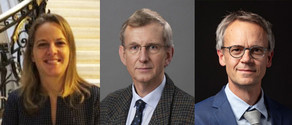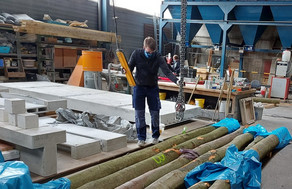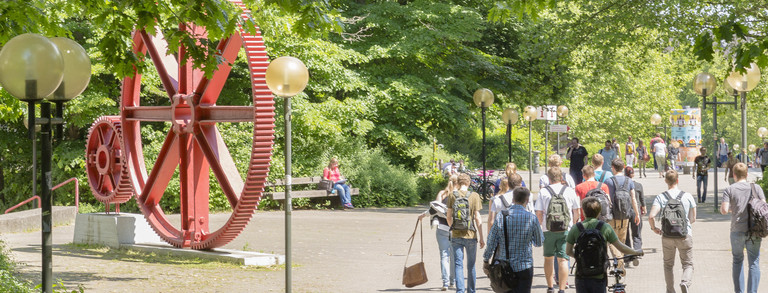Presentations at the ICBBM
Simon Loske and Jan Wulf present their research with the TU Dortmund University at the ICBBM (Fifth International Conference on Bio-Based Building Materials) in Vienna. The thematic content of the conference was on innovative bio-building materials and technologies with the goal of sustainable development.
A minimally invasive anchoring technique for the foundation of technical structures in trees
Simon Loske1, Ingo Muench1, Panagiotis Spyridis1, Zeller Martin2
1TU Dortmund University, Germany; 2Technische Überprüfungsgesellschaft mbH, Eichstetten, Germany
Topics: Innovation (Innovative hybrid composites natural fibres, Vegetable waste materials and natural bio-admixtures for binders, Material treatments of 3 BM, Advances in research methodologies and bio-materials testing, Constr. with low binder sprayed concrete, Sustainability and case studies (Construction materials and technologies for sustainability, energy efficiency, Life-cycle assessment of 3BM, Green and renewable energy applications in constr., Eco-friendly binders with low CO2-emission)
Keywords: Construction with trees, fastening, anchoring, tree house building
We present motivation, ideas, experiments, and numerical results for the anchor-ing of buildings or technical elements into trees. The task here is interdisciplinary since the tree with its biological tissues does not represent a building material in the classical sense, but is used for building through the intended use. Therefore, as in medicine, a minimally invasive procedure must impart forces into the hard tissue layers via a technical connector, considering the metabolism as well as the growth processes of the tree. Our hypothesis is, that in this context only a two-bolt solution offers an acceptable anchoring technique to fulfill building laws. The consideration of biological aspects into the solution has also relevance in terms of the building law, as the durability and reliability of the connection depends on the vitality of the tree. However, such an anchoring technique opens up new and eco-logically oriented construction methods, which enable the preservation of tree populations in civil development areas.
First, by analysis of existing anchoring techniques different concepts are dis-cussed. Then, the load capacity of a minimally invasive anchoring technique is investigated in a series of load tests including interpretation. Finally, we propose a solution based on two bolts with rigid coupling in order to significantly increase the load capacity of the connection.
Residual stresses in green wood based on a phase field model
Jan Bernd Wulf, Ingo Münch
TU Dortmund University, Germany
Topics: Materials, characterisation, design and test methods (Natural fibres and materials, Design with natural fibre composites, wood, bamboo for structures, Earthen ramped, Test methods)
Keywords: Phase field model, tree engineering, green wood, residual stresses, stress-induced growth, transverse isotropy, viscoelasticity
In order to achieve the goals of the Paris Climate Agreement, it is increasingly important for the Parties to take climate-friendly decisions beyond the energy sector. In the construction industry, CO2 savings are possible by the choice of building materials, the construction process, but also by avoiding land sealing. Building in living trees combines more than one of these aspects. However, there are no regulations for the load transfer of trees in the applicable construction standards. As there is an increasing interest from investors to realise building projects in trees, e.g. for use as a hotel, a safety concept for building in trees is still requested.
Compared to experimental bending tests, basic numerical models tend to undervalue the load-bearing capacity of green wood. A familiar reason for this is the fact that the growth of the tree induces a residual stress state decreasing the compressive stress towards the trunk surface. Since the tensile strength of wood is commonly higher than the compressive strength, an overall stress state is obtained increasing the load-bearing capacity. Determining the residual growth stress provides a basis for an improved safety concept for building in trees.
The residual stress state is a non-linear function in the transverse direction. To calculate this state over time, a phase field model is utilised. The viscoelastic material behaviour of the green wood has a significant influence on the resulting stress curve in the cross-section and needs to be considered for a more detailed evaluation. Since both processes are physically justified, a coordination of the time scales is essential.
The description of the geometry is based on the actual state of the tree. An individual tree morphology defines a predefined growth orientation within the phase field model, forming the basis for primary growth. Thus, the model is independent of numerous tropisms and their triggers, which generate random tree geometries. In addition, there is secondary growth corresponding to the increase in thickness. In temperate climates, this growth is associated with growth rings, a property of the modelled material. While various tropisms are decisive for the off-centre accumulation of wood material in the branch structure, only stress-induced growth applies in the trunk area. In the model, this mechanism responds to either the principal tensile stress or the principal compressive stress, a difference that exists for hardwoods and softwoods.
The wood matrix is anisotropic with a specific orientation of fibres, therefore a transversely isotropic material law applies to the green wood in the model.






